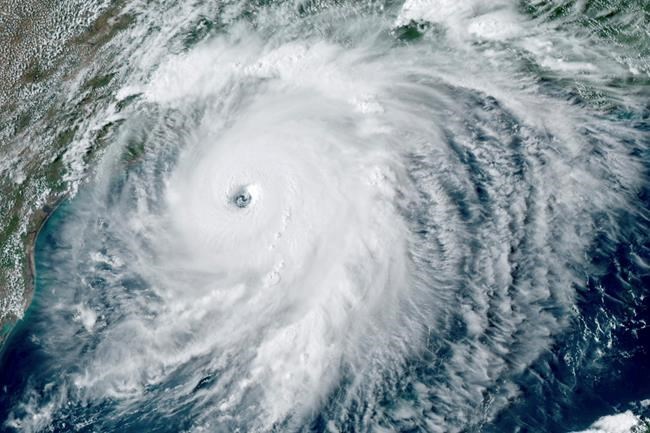
This GOES-16 GeoColor satellite image taken Wednesday, Aug. 26, 2020, at 4:50 p.m. EDT., and provided by NOAA, shows Hurricane Laura over the Gulf of Mexico. Hurricane Laura strengthened Wednesday into “an extremely dangerous Category 4 hurricane," The National Hurricane Center said. Laura is expected to strike Wednesday night into Thursday morning along the Louisiana-Texas border. (NOAA via AP)
Republished August 26, 2020 - 6:15 PM
Original Publication Date August 26, 2020 - 5:01 PM
Dozens of nursing homes evacuated their residents as Hurricane Laura bore down Wednesday, but many others with a choice just stayed put, concluding the risk of breaking their coronavirus lockdowns could be more deadly than the storm.
“It is always best if you can remain in an environment that is familiar,” said Charles Solomon, who runs The Resort at Texas City, a nursing home with 79 residents near the Galveston Bay shoreline.
The facility suffered a COVID-19 outbreak that infected 55 residents, killing 17, but now is free of cases. Because it is outside the evacuation zone and has never flooded in the past, the staff decided it would be best to stay in place, particularly given fears of reintroducing the virus.
“Since we are a COVID-free facility, it would be best to remain that way,” Solomon said.
Shifting storm tracks and the trauma of transferring vulnerable residents can make the calculus of whether to stay or to go difficult for nursing home operators. The added risk of virus exposure convinced some homes that they’re better off braving the storm in place.
Others, largely those under mandatory evacuation orders, have scrambled to move residents inland as Laura nears. The Texas Health and Human Services Commission said 64 long-term care facilities housing about 1,500 residents had evacuated as of Wednesday afternoon. In Louisiana, more than 800 residents in 11 nursing homes were also evacuated, according to the state health department.
Ron Payne, CEO of Southwest LTC, which runs nursing homes across Texas, has been through multiple storm evacuations over the years. But this week’s evacuations of about 350 residents at four of his homes were far different than any in the past.
He needed twice as many buses, ambulances and other vehicles to move residents to ensure COVID-19 patients weren’t transported alongside uninfected people. Staff were dressed, head to toe, in protective gear. And facilities’ emergency plans on where they would dispatch residents to were upended if those facilities weren’t admitting those with the coronavirus.
“COVID put a big challenge into what we have had to do,” he said.
State and federal rules mandate nursing homes have emergency plans in place, including details on where residents will be sent and how their families will be notified.
A 2012 report from the U.S. Department of Health and Human Services’ inspector general found that the vast majority of nursing homes comply with such requirements but serious gaps persisted, including transportation contracts the audit found were often unreliable.
Hurricane Laura is due to hit Texas as its long-term care homes have already been on edge in an unprecedented lockdown to try and keep further virus outbreaks from arising.
“Just when you think it couldn’t get worse, there’s this,” said Kevin Warren of the Texas Health Care Association, which represents nursing homes and assisted living facilities.
New pandemic precautions have had evacuating facilities adapting their plans, including introducing social distancing measures on departing buses.
“Keeping residents safe just takes on a much bigger meaning,” said Lisa Baker, an expert on disaster preparedness at Samford University in Birmingham, Alabama, who co-authored the book “Vulnerable Populations and Disasters.” “Now there’s kind of multiple risk factors.”
Hurricanes have repeatedly brought stories of facility residents suffering and dying in the aftermath.
Hurricane Andrew caused a diaspora of nursing home residents, and family members frantically searched to locate elderly relatives. Hurricane Katrina was followed by harrowing tales from St. Rita’s nursing home, where dozens died. And Hurricane Harvey washed through La Vita Bella assisted living facility, and brought a viral photo of elderly women sitting in deep floodwaters while they awaited rescue.
But evacuations, too, have brought pain and death, most notably 15 years ago as Hurricane Rita neared and a bus evacuating residents of a Houston-area home caught fire and killed 23.
The horror of that evacuation has colored nursing home administrators' decisions in the years since, said Greg Shelley, program manager of the Harris County Long-term Care Ombudsman Program at Cizik School of Nursing at UTHealth in Houston.
“They have to weigh that, knowing that there is a chance that the trip alone and the whole process and logistics of trying to move people out with all of those different needs is potentially dangerous as well,” Shelley said.
Erika Parrish, administrator of the Bayou Pines Care Center in La Marque, Texas, in Galveston County, said her facility loaded up with enough food and supplies to last two weeks and feeding pumps and other devices plugged into outlets that will be fueled by a generator if power fails.
Bayou Pines didn’t flood when Harvey hit and sheltering in place, Parrish said, made the most sense given the pandemic.
“Leaving is the very, very last thing you want to do especially now that things are a lot different with COVID,” she said.
On Wednesday night, as Hurricane Laura neared, she and other staff members will hunker down in the home, grabbing naps in empty rooms. They’ve made plans for socially distant movie screenings, complete with frozen margaritas for their 79 residents. Even if other staffers have trouble reaching the facility, she knows they’ll be equipped to take care of residents’ needs.
“We’re ready for anything,” she said.
___
Sedensky can be reached at msedensky@ap.org and https://twitter.com/sedensky.
News from © The Associated Press, 2020